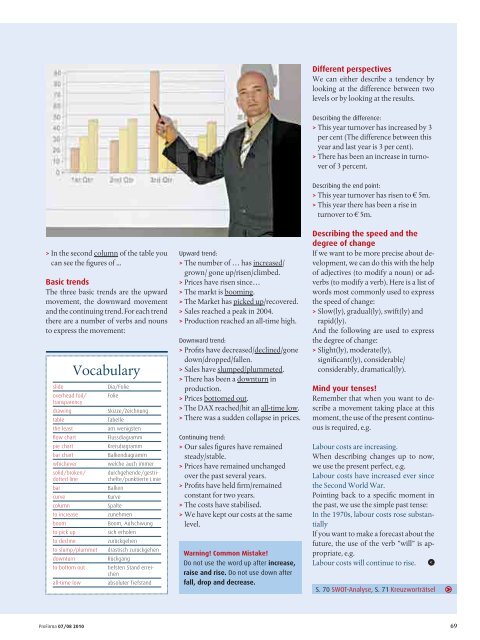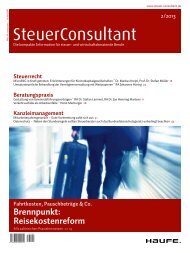Als PDF downloaden - Haufe.de
Als PDF downloaden - Haufe.de
Als PDF downloaden - Haufe.de
Sie wollen auch ein ePaper? Erhöhen Sie die Reichweite Ihrer Titel.
YUMPU macht aus Druck-PDFs automatisch weboptimierte ePaper, die Google liebt.
Different perspectives<br />
We can either <strong>de</strong>scribe a ten<strong>de</strong>ncy by<br />
looking at the difference between two<br />
levels or by looking at the results.<br />
Describing the difference:<br />
> This year turnover has increased by 3<br />
per cent (The difference between this<br />
year and last year is 3 per cent).<br />
> There has been an increase in turnover<br />
of 3 percent.<br />
> In the second column of the table you<br />
can see the figures of ...<br />
Basic trends<br />
The three basic trends are the upward<br />
movement, the downward movement<br />
and the continuing trend. For each trend<br />
there are a number of verbs and nouns<br />
to express the movement:<br />
Vocabulary<br />
sli<strong>de</strong><br />
overhead foil/<br />
transparency<br />
drawing<br />
table<br />
the least<br />
fl ow chart<br />
pie chart<br />
bar chart<br />
whichever<br />
solid/broken/<br />
dotted line<br />
bar<br />
curve<br />
column<br />
to increase<br />
boom<br />
to pick up<br />
to <strong>de</strong>cline<br />
to slump/plummet<br />
downturn<br />
to bottom out<br />
all-time low<br />
Dia/Folie<br />
Folie<br />
Skizze/Zeichnung<br />
Tabelle<br />
am wenigsten<br />
Flussdiagramm<br />
Kreisdiagramm<br />
Balkendiagramm<br />
welche auch immer<br />
durchgehen<strong>de</strong>/gestrichelte/punktierte<br />
Linie<br />
Balken<br />
Kurve<br />
Spalte<br />
zunehmen<br />
Boom, Aufschwung<br />
sich erholen<br />
zurückgehen<br />
drastisch zurückgehen<br />
Rückgang<br />
tiefsten Stand erreichen<br />
absoluter Tiefstand<br />
Upward trend:<br />
> The number of … has increased/<br />
grown/ gone up/risen/climbed.<br />
> Prices have risen since…<br />
> The markt is booming.<br />
> The Market has picked up/recovered.<br />
> Sales reached a peak in 2004.<br />
> Production reached an all-time high.<br />
Downward trend:<br />
> Profits have <strong>de</strong>creased/<strong>de</strong>clined/gone<br />
down/dropped/fallen.<br />
> Sales have slumped/plummeted.<br />
> There has been a downturn in<br />
production.<br />
> Prices bottomed out.<br />
> The DAX reached/hit an all-time low.<br />
> There was a sud<strong>de</strong>n collapse in prices.<br />
Continuing trend:<br />
> Our sales figures have remained<br />
steady/stable.<br />
> Prices have remained unchanged<br />
over the past several years.<br />
> Profits have held firm/remained<br />
constant for two years.<br />
> The costs have stabilised.<br />
> We have kept our costs at the same<br />
level.<br />
Warning! Common Mistake!<br />
Do not use the word up after increase,<br />
raise and rise. Do not use down after<br />
fall, drop and <strong>de</strong>crease.<br />
Describing the end point:<br />
> This year turnover has risen to € 5m.<br />
> This year there has been a rise in<br />
turnover to € 5m.<br />
Describing the speed and the<br />
<strong>de</strong>gree of change<br />
If we want to be more precise about <strong>de</strong>velopment,<br />
we can do this with the help<br />
of adjectives (to modify a noun) or adverbs<br />
(to modify a verb). Here is a list of<br />
words most commonly used to express<br />
the speed of change:<br />
> Slow(ly), gradual(ly), swift(ly) and<br />
rapid(ly).<br />
And the following are used to express<br />
the <strong>de</strong>gree of change:<br />
> Slight(ly), mo<strong>de</strong>rate(ly),<br />
significant(ly), consi<strong>de</strong>rable/<br />
consi<strong>de</strong>rably, dramatical(ly).<br />
Mind your tenses!<br />
Remember that when you want to <strong>de</strong>scribe<br />
a movement taking place at this<br />
moment, the use of the present continuous<br />
is required, e.g.<br />
Labour costs are increasing.<br />
When <strong>de</strong>scribing changes up to now,<br />
we use the present perfect, e.g.<br />
Labour costs have increased ever since<br />
the Second World War.<br />
Pointing back to a specific moment in<br />
the past, we use the simple past tense:<br />
In the 1970s, labour costs rose substantially<br />
If you want to make a forecast about the<br />
future, the use of the verb ”will” is appropriate,<br />
e.g.<br />
Labour costs will continue to rise.<br />
S. 70 SWOT-Analyse, S. 71 Kreuzworträtsel<br />
ProFirma 07/08 2010<br />
69

















